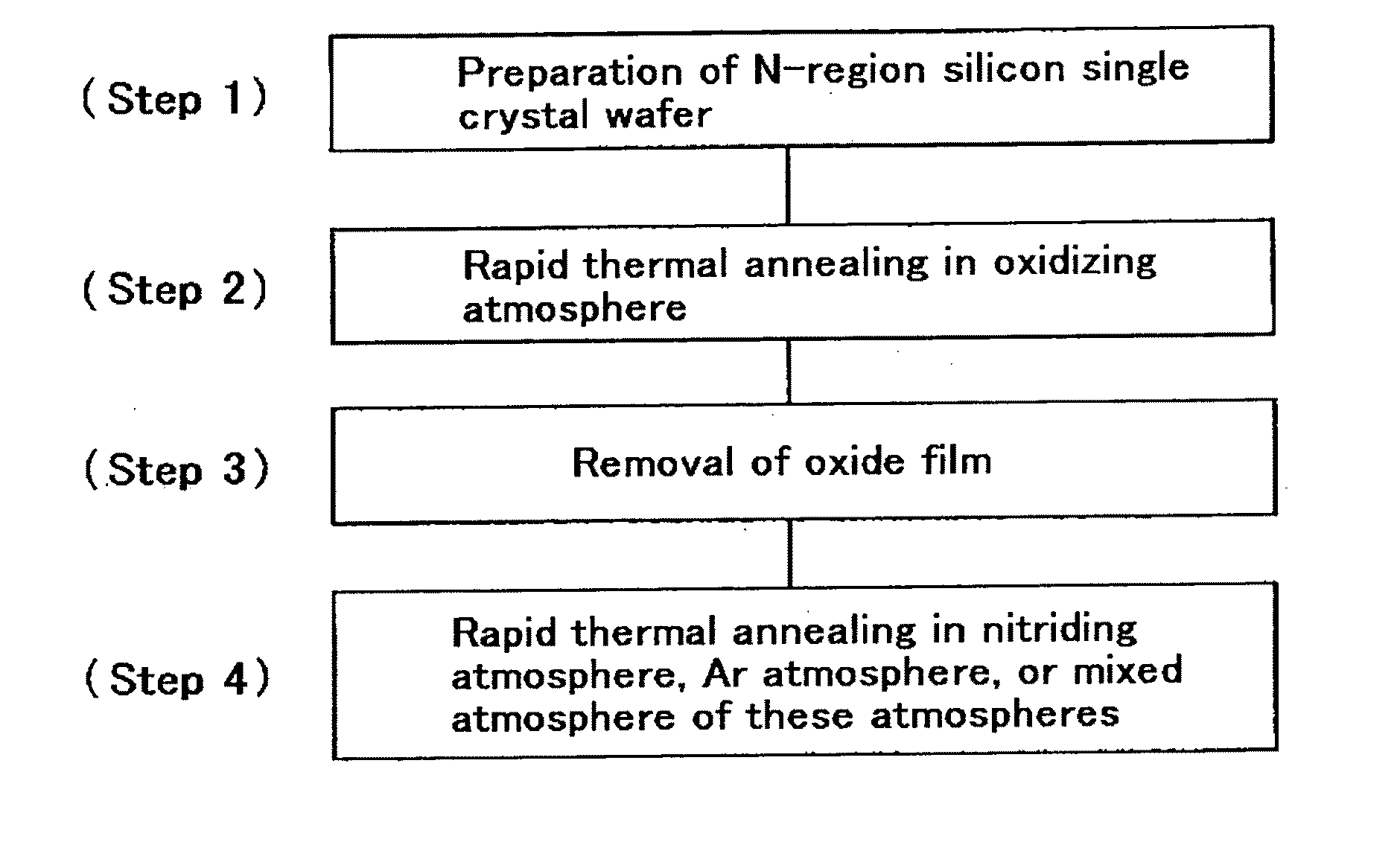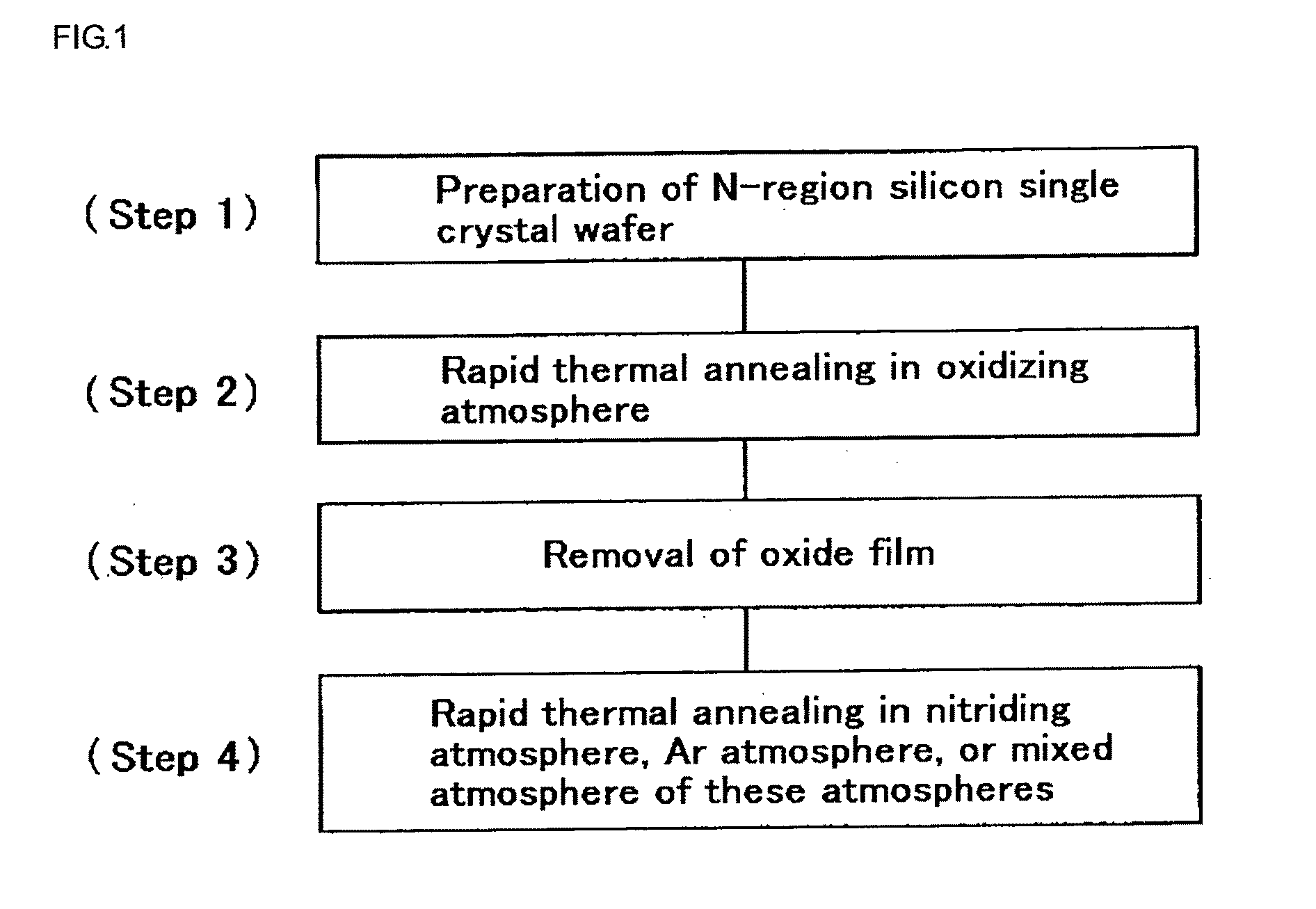Method for manufacturing silicon single crystal wafer
- Summary
- Abstract
- Description
- Claims
- Application Information
AI Technical Summary
Benefits of technology
Problems solved by technology
Method used
Image
Examples
Example
EXAMPLE 1, COMPARATIVE EXAMPLE 1
[0083]A p-type silicon single crystal ingot which has a resistivity of 9.2 Ωcm, an initial oxygen concentration of 11.0 ppma (JEIDA), an N region in the entire plane (an Ni region at a central portion, an Nv region at an outer peripheral portion), and a diameter of 300 mm and in which 102 OSFs are detected per cm2 in the outer peripheral portion by a high-sensitivity OSF inspection was grown by using the single-crystal pulling apparatus 1 depicted in FIG. 2, and wafers sliced out from this silicon single crystal ingot and subjected to a chemical etching process were prepared (CW wafers) for Example 1 and Comparative Example 1, respectively.
[0084]As Example 1 corresponding to the manufacturing method according to the present invention, such a rapid thermal annealing apparatus 12 as shown in FIG. 3 was used to increase a temperature of the CW wafer in a dry oxygen atmosphere at a temperature-up speed of 50° C. / s, perform a rapid oxidation heat treatme...
Example
[0088]Further, as Comparative Example 1 corresponding to a conventional manufacturing method, RTA processing on a second stage, thermal simulation simulating a device manufacturing process, and measurement of oxide dielectric breakdown voltage characteristics were performed in the same way as Example 1 except that RTO processing on a first stage and subsequent HF cleaning was not carried out.
[0089]FIG. 4 shows TDDB evaluation results of Example 1 and Comparative Example 1. An abscissa in the graph represents a maximum temperature in the RTO processing on the first stage, and an ordinate of the same represents a percentage of cells in a wafer that are 5C / cm2 or above when a constant current TDDB was evaluated (i.e., a percentage of cells that were not broken even though charged to 5C / cm2) as a yield.
[0090]In the CW wafer utilized this time, TDDB characteristics were lowered in a region of a wafer outer peripheral portion where an OSF was detected in a preliminary high-sensitivity OSF...
Example
EXAMPLE 2, COMPARATIVE EXAMPLE 2
[0092]A p-type silicon single crystal ingot which has a resistivity of 10.2 Ωcm, an initial oxygen concentration of 10.9 ppma (JEIDA), an N region in the entire plane (an Ni region at a central portion, an Nv region at an outer peripheral portion), and a diameter of 300 mm and in which 76 OSFs are detected per cm2 in the outer peripheral portion by a high-sensitivity OSF inspection was grown, and wafers sliced out from this silicon single crystal ingot and subjected to a chemical etching process were prepared (CW wafers) for Example 2 and Comparative Example 2, respectively.
PUM
 Login to View More
Login to View More Abstract
Description
Claims
Application Information
 Login to View More
Login to View More - R&D
- Intellectual Property
- Life Sciences
- Materials
- Tech Scout
- Unparalleled Data Quality
- Higher Quality Content
- 60% Fewer Hallucinations
Browse by: Latest US Patents, China's latest patents, Technical Efficacy Thesaurus, Application Domain, Technology Topic, Popular Technical Reports.
© 2025 PatSnap. All rights reserved.Legal|Privacy policy|Modern Slavery Act Transparency Statement|Sitemap|About US| Contact US: help@patsnap.com



